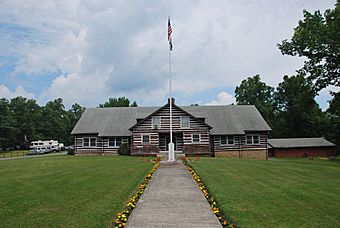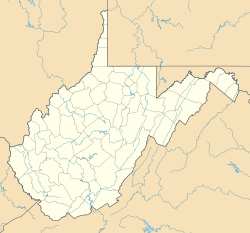Camp Washington-Carver Complex facts for kids
Quick facts for kids |
|
|
Camp Washington-Carver Complex
|
|

Great Chestnut Lodge in July 2014
|
|
| Location | County Route 11/3, near Clifftop, West Virginia |
|---|---|
| Area | 30 acres (12 ha) |
| Built | 1939 |
| Architect | West Virginia State Board of Control |
| Architectural style | Log construction |
| NRHP reference No. | 80004017 |
| Added to NRHP | June 20, 1980 |
The Camp Washington-Carver Complex is a very special place in West Virginia. It used to be known as the West Virginia 4-H Camp for Negroes. This camp is a historic camp and a historic area located near Clifftop, West Virginia. It's important because of its unique buildings and its history. Today, it serves as a lively cultural arts center.
About Camp Washington-Carver
This historic area includes four important buildings and two other structures. The most famous building here is the Great Chestnut Lodge. It's a very large building made entirely of chestnut logs. It's the biggest log structure of its kind in West Virginia.
The Great Chestnut Lodge was built between 1941 and 1942. It's a story-and-a-half building shaped like a modified cross. It has a main assembly hall and a dining hall wing. Other buildings on the property include a log cottage from 1940, two dormitories from 1942, a water tower from 1940, and a small pond also from 1940.
How the Camp Started
The idea for Camp Washington-Carver began in 1928. At that time, many counties had 4-H camps for white children. However, there were no such camps for African American children.
John W. Davis, who was the president of West Virginia State College, helped lead the effort. He worked to get support from the state and federal governments. The camp was officially established by the West Virginia legislature in 1937.
Building the camp was a project of the Works Progress Administration (WPA). The WPA was a government program that created jobs during the Great Depression. Construction started in 1939, and the camp officially opened in 1942.
A Place of Change
Over time, camps in West Virginia became desegregated. This means that people of all races could attend them together. Camp Washington-Carver played an important role in this history.
The camp was added to the National Register of Historic Places in 1980. This means it's recognized as a significant historic site. A special historical marker at the site tells its story.
Today, the Camp Washington-Carver Complex is a vibrant cultural arts center. It hosts many events, including The Appalachian String Band Music Festival. This festival celebrates traditional music and brings many people together.



